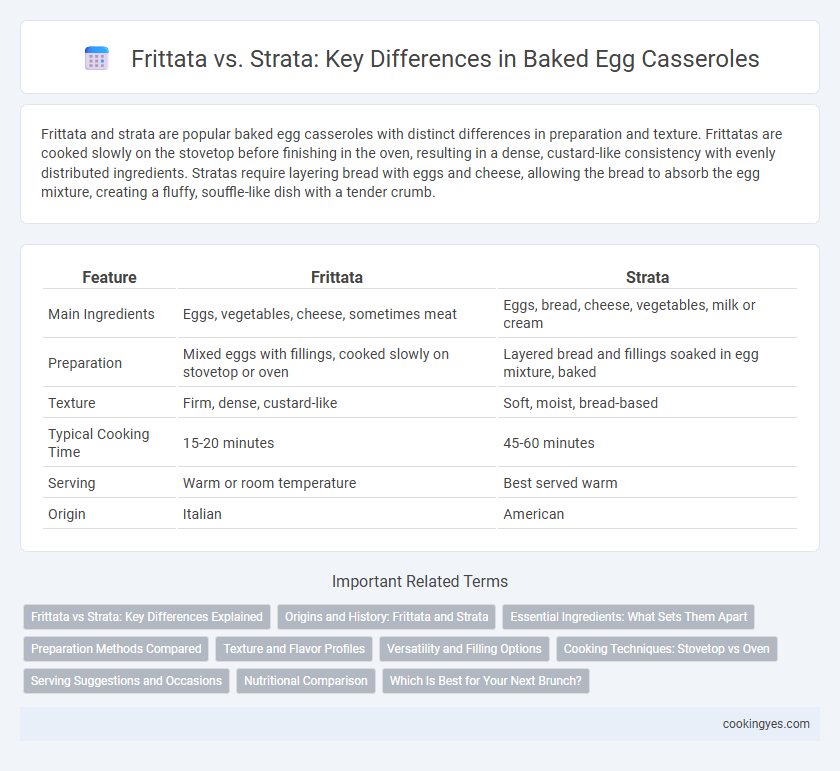Frittata and strata are popular baked egg casseroles with distinct differences in preparation and texture. Frittatas are cooked slowly on the stovetop before finishing in the oven, resulting in a dense, custard-like consistency with evenly distributed ingredients. Stratas require layering bread with eggs and cheese, allowing the bread to absorb the egg mixture, creating a fluffy, souffle-like dish with a tender crumb.
Table of Comparison
| Feature | Frittata | Strata |
|---|---|---|
| Main Ingredients | Eggs, vegetables, cheese, sometimes meat | Eggs, bread, cheese, vegetables, milk or cream |
| Preparation | Mixed eggs with fillings, cooked slowly on stovetop or oven | Layered bread and fillings soaked in egg mixture, baked |
| Texture | Firm, dense, custard-like | Soft, moist, bread-based |
| Typical Cooking Time | 15-20 minutes | 45-60 minutes |
| Serving | Warm or room temperature | Best served warm |
| Origin | Italian | American |
Frittata vs Strata: Key Differences Explained
Frittata and strata are both baked egg casseroles but differ fundamentally in preparation and texture. A frittata is an Italian-style open-faced omelet cooked slowly on the stovetop then finished in the oven, emphasizing eggs and minimal bread, creating a dense, custardy texture. Strata, a layered casserole originating from American cuisine, incorporates bread soaked in an egg mixture, resulting in a soft, bread pudding-like consistency with added fillings like cheese, meats, and vegetables.
Origins and History: Frittata and Strata
Frittata originates from Italy as a simple, open-faced egg dish traditionally cooked on the stovetop before finishing in the oven, reflecting its Mediterranean roots. Strata, an American creation from the mid-20th century, evolved as a layered baked egg casserole combining bread, eggs, and cheese, designed for make-ahead convenience and brunch settings. Both dishes showcase regional variations in baked egg casseroles, with frittata emphasizing minimal ingredients and quick preparation, while strata highlights layering and soak-in flavors through bread integration.
Essential Ingredients: What Sets Them Apart
Frittatas contain beaten eggs mixed with ingredients like vegetables, cheese, and meats, baked or cooked slowly on the stovetop without bread. Stratas are layered casseroles featuring bread soaked in an egg and dairy mixture, combined with cheeses, meats, and vegetables before baking. The essential difference lies in the use of bread as a foundational ingredient in stratas, which creates a custard-like texture, whereas frittatas focus on eggs as the primary binder.
Preparation Methods Compared
Frittata preparation involves directly cooking beaten eggs with ingredients in a skillet, finishing under the broiler or stovetop until set, emphasizing a quick and simple method without layering. Strata requires layering bread soaked in an egg mixture with cheese, vegetables, and meats before baking slowly, allowing flavors to meld and the custard to develop its characteristic texture. This contrast highlights the frittata's speed and minimal preparation versus the strata's process-intensive soaking and assembly.
Texture and Flavor Profiles
Frittatas feature a dense, custard-like texture with eggs cooked slowly to maintain moisture and a creamy consistency, while strata offers a layered structure with bread soaked in eggs, creating a more bread-forward, airy texture. Flavor-wise, frittatas highlight the richness of eggs and cheese, often enhanced with vegetables and meats evenly distributed throughout. Strata's flavor profile leans toward savory, with the bread absorbing herbs, cheeses, and fillings, resulting in a more complex, almost savory pudding taste.
Versatility and Filling Options
Frittatas offer exceptional versatility with their open-faced design, allowing a wide range of fillings such as vegetables, cheeses, and meats to be evenly distributed throughout the eggs. Stratas, by contrast, incorporate layers of bread or other starches soaked in egg mixture, resulting in a heartier dish with more substantial texture. The absence of bread in frittatas provides a lighter option while still accommodating diverse flavor combinations, making them ideal for both quick meals and elegant presentations.
Cooking Techniques: Stovetop vs Oven
Frittatas are primarily cooked on the stovetop, starting with sauteing ingredients in a skillet before gently finishing under low heat or briefly in the oven to set the eggs without browning. In contrast, strata casseroles rely on an entirely oven-based baking process, allowing layers of bread, eggs, and fillings to meld and rise, creating a custard-like texture. The stovetop method used for frittatas yields a tender, slightly crisp edge, while oven-baked strata develop a more uniform, golden crust with a soft, airy interior.
Serving Suggestions and Occasions
Frittatas offer versatile serving options, ideal for brunches, light lunches, or dinner parties, and can be served hot or at room temperature, making them perfect for casual family gatherings and elegant events alike. Strata, often layered with bread, cheese, and vegetables, is best served warm and suits breakfast buffets, holiday brunches, and potlucks where guests can easily serve themselves. Both dishes complement fresh salads, roasted vegetables, and artisan breads, enhancing the dining experience across various occasions.
Nutritional Comparison
Frittatas generally contain fewer carbohydrates and calories than strata due to the absence of bread or other starchy ingredients, making them a lighter baked egg casserole option. Strata often incorporates bread, which increases carbohydrate content and contributes additional fiber, vitamins, and minerals depending on the bread type used. Both dishes provide high-quality protein and essential nutrients from eggs, but frittatas offer a more protein-dense profile with lower calorie density.
Which Is Best for Your Next Brunch?
Frittatas offer a versatile, crustless baked egg casserole ideal for quick brunches, emphasizing fresh vegetables and cheeses folded into beaten eggs before cooking. Stratas, on the other hand, are layered egg casseroles combining bread, cheese, and meats soaked overnight for a richer, custard-like texture that enhances flavor depth. Choose a frittata for a light, speedy meal and a strata when planning a flavorful, make-ahead brunch centerpiece.
Frittata vs Strata for baked egg casseroles Infographic

 cookingyes.com
cookingyes.com